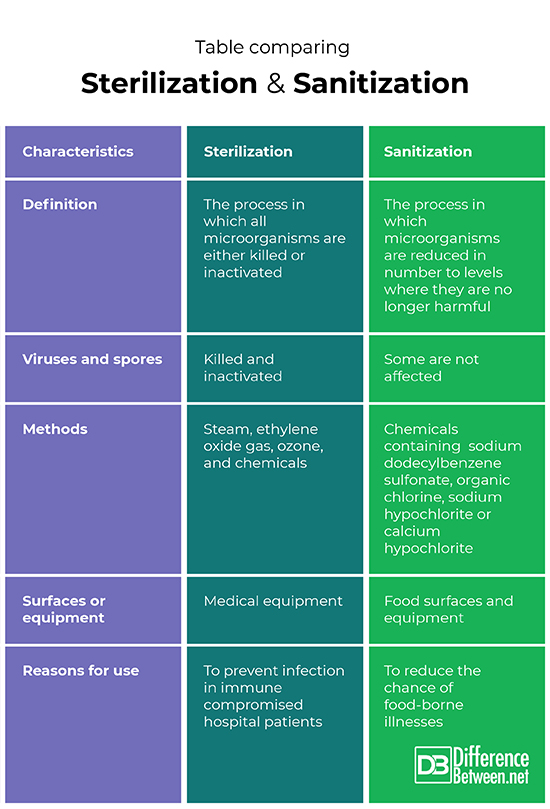Difference Between Sterilization and Sanitization
What is Sterilization?
Definition:
Sterilization is the process in which all microorganisms are either inactivated or are killed outright. It involves using temperatures, various chemicals, or gas, to destroy microbes that may cause contamination or disease.
Methods:
There are various ways in which surfaces and equipment can be successfully sterilized. Steam is a popular way but cannot be used for heat sensitive items. In those cases other methods need to be used such as ozone, ethylene oxide gas or liquid chemicals. An autoclave can be used for equipment that is not heat sensitive. This instrument uses a combination of high temperature and pressure to kill microbes. The ethylene oxide gas has the disadvantage of being harmful to people so the autoclave method is used as much as possible.

What is Sterilized:
A great deal of medical equipment needs to be sterilized including cardiac catheters, implants and any instruments used to perform surgery. Without sterilization the risk of infection can be very high and patients can come become very ill and may even die.
Reasons for Sterilization:
Sterilization procedures are most typically found in medical facilities such as hospitals where it is crucial that all microbes are killed. This is because hospital patients already have a compromised immune system making them less able to fight off microbes when compared with healthy people.
Effects on Microbes:
When microorganisms are exposed to steam; the high temperatures work by destroying the proteins of the bacteria. Since enzymes are proteins this means that all the enzymes of the microbe are destroyed such that the organism cannot survive. Ozone molecules kill bacteria and other microbes by destroying the cell wall of the organism. It literally makes holes in the cell wall of the bacterial or fungal cell, which then causes the microbe to perish. Ethylene oxide gas destroys the DNA and can in this way stop microbes from reproducing; it can also destroy viruses and spores. Research has shown it to be very effective, for instance, in inactivating pox virus and enteroviruses.

What is Sanitization?
Definition:
Sanitization is the process in which pathogenic microorganisms are reduced in number so that they are no longer harmful; this usually means that more than 99.99% of microbes need to be removed from surfaces. Some viruses and spores are not affected by sanitization though. Sanitizing needs to be done often enough so that you avoid having thick layers of bacteria (biofilms) developing.
Methods:
Surfaces should be cleaned first then a sanitizer should be applied. Various chemicals can be used as sanitizing agents, including chemicals that contain sodium dodecylbenzene sulfonate. Chemicals such as calcium hypochlorite and sodium hypochlorite, organic chlorine (sodium dichloroisocyanurate), and chlorine gas can all be used. Different chemicals have advantages and disadvantages. Quaternary ammonium compounds are also very good as sanitizers for surfaces and for equipment. It is important that individuals follow the directions carefully so that they can achieve the desired reduction in microbial numbers. That is to say that 99.99% of microbes should be reduced within half a minute of applying the substance.
What is Sanitized:
Surfaces that are used to prepare food should be sanitized often to reduce the degree of microbial contamination. This is very important as food-borne microbes cause many illnesses and deaths every year.
Reasons for Sanitization:
Sanitization helps to prevent people getting ill from microbes carried on food items. This is important since cross contamination from one food to another can occur if food preparation surfaces are not kept adequately sanitized.
Effects on Microbes:
Chemicals with hypochlorite present tend to work by severely compromising the permeability of the bacterial membrane. They also help destroy the genetic material and enzymes of the bacterial cell. Spores are mostly not affected because they have a strong coat. The quaternary ammonium compounds also work by impacting the bacterial cell membrane, particularly the phospholipids.
Difference Between Sterilization and Sanitization
-
Definition
Sterilization is the process by which all microorganisms are directly killed or are inactivated. Sanitization is the process by which the numbers of microorganisms are substantially reduced, usually by 99.99%.
-
Viruses and Spores
Sterilization will inactivate all spores and viruses while sanitization will not have an impact on some viruses and spores.
-
Methods
Sterilization can be achieved using steam (high pressures and temperatures), ethylene oxide gas, chemicals or ozone. Sanitization can be accomplished using chemicals containing such substances as sodium hypochlorite, calcium hypochlorite, organic chlorine, and sodium dodecylbenzene sulfonate.
-
Surfaces or Equipment
Sterilization is typically used on medical surfaces and equipment. Sanitization is typically used on surfaces and on equipment that are used to prepare food.
-
Reasons for Use
The sterilization process is used most often in medical facilities to help prevent infection in immune-compromised hospital patients. The sanitization process is used in the food industry to reduce the chance of people becoming ill from food that has been contaminated from surfaces and equipment that has lots of microbes present.
Table Comparing Sterilization and Sanitization

Summary of Sterilization Vs. Sanitization
- Sterilization and sanitization are both important but sterilization kills and inactivates all microbes.
- Sterilization and sanitization help to keep people from becoming sick.
- The process of sterilization is very important for use in medical facilities where people have a compromised immune system.
- The process of sanitization is important in the food industry for helping keep food preparation surfaces and equipment clean enough to prevent too many microbes from growing and forming thick layers.
- Sanitization is more concerned with reducing the amount of microbes on surfaces to very low numbers.
- Both sanitization and sterilization attack various components of the microbial cell itself to either stop microbes reproducing or to kill and inactivate them directly.
- Difference Between Rumination and Regurgitation - June 13, 2024
- Difference Between Pyelectasis and Hydronephrosis - June 4, 2024
- Difference Between Cellulitis and Erysipelas - June 1, 2024
Search DifferenceBetween.net :
1 Comment
Leave a Response
References :
[0]Editors of Encyclopedia Britannica. “Antimicrobial Agent”. Science. Encyclopedia Britannica, 2018, https://www.britannica.com/science/antimicrobial-agent#ref351
[1]Jordy, A, et al. “Virus inactivation by ethylene oxide containing gases.” Acta veterinaria Scandinavica 16.3 (1975): 379-387.
[2]Van Houdt, Rob, and Chris W. Michiels. "Biofilm formation and the food industry, a focus on the bacterial outer surface." Journal of applied microbiology 109.4 (2010): 1117-1131.
[3]Image credit: https://media.defense.gov/2010/Jul/23/2000340801/888/591/0/100723-F-8380B-003.JPG
[4]Image credit: https://media.defense.gov/2017/Jun/30/2001771823/431/300/0/170628-F-WT432-1007.JPG

This is good comparison